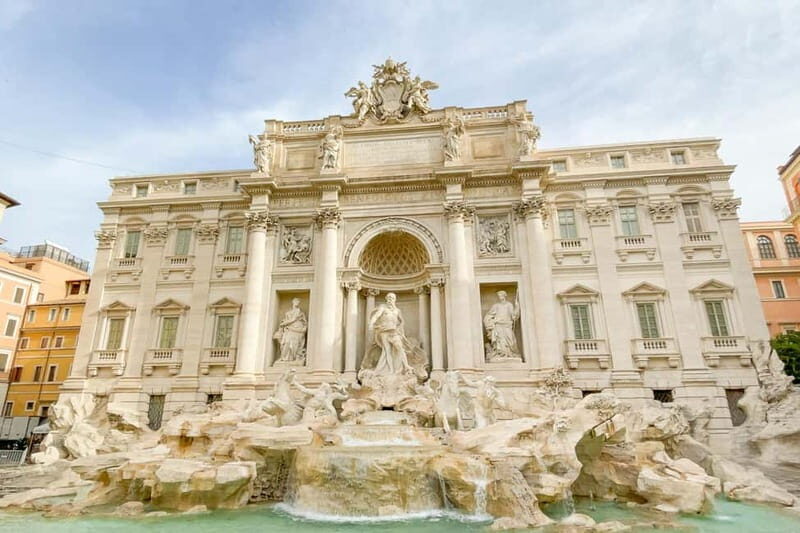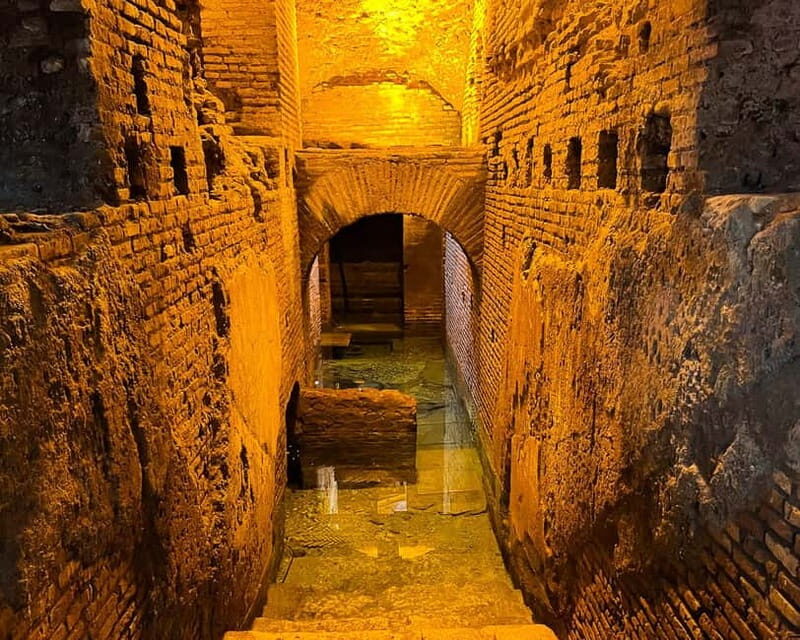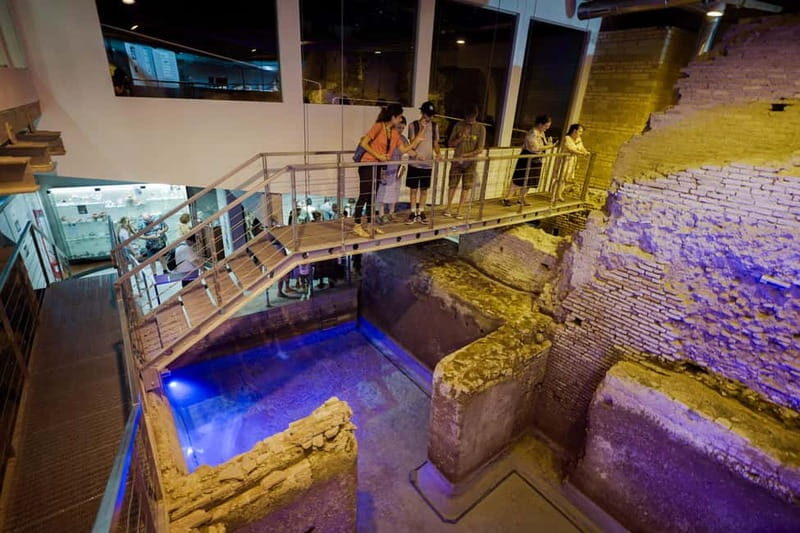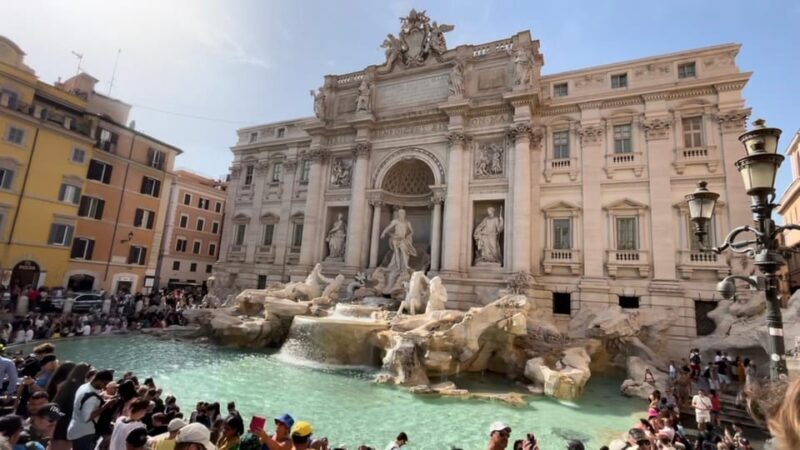Planning a trip to Rome usually involves iconic sights like the Trevi Fountain and the Spanish Steps. But what if you could see these famous landmarks from a completely different perspective — underground, where ancient engineering still flows beneath the city? That’s exactly what this small-group tour offers, guiding you through the hidden waterworks that helped shape Rome’s history.
We’re impressed by how this tour combines storytelling, authentic ruins, and the chance to step into some of the city’s lesser-known underground sites. Two aspects stand out: the personalized attention that comes from small groups (no more than 12 participants) and the exclusive access to ancient aqueducts still carrying water today.
However, one thing to consider is that the tour involves walking through narrow underground passages and some uneven surfaces. Travelers who dislike tight spaces or have mobility issues might want to think twice.
This experience is ideal for history buffs, architecture lovers, or anyone curious about how Rome’s water system enabled its growth. It’s perfect for those wanting an engaging, educational adventure that’s off the beaten path of typical sightseeing.
Key Points

- Intimate Group Size: Maximum 12 people for a more personal, engaging experience.
- Underground Access: Includes visits to ancient aqueducts and water reservoirs still flowing today.
- Educational & Authentic: Learn about Rome’s water supply, aqueduct engineering, and how the city was built around it.
- Rich Context: Guides provide extensive storytelling, making the ruins and waterworks come alive.
- Convenient & Flexible: Tours run rain or shine, with multiple start times, and include entry to key underground sites.
- Good Value: Combines multiple sites with expert-guided storytelling, making it a worthwhile investment.
Exploring the Itinerary: What You’ll Experience

You can also read our reviews of more tours and experiences in Rome.
Starting Point: Piazza di Spagna
Your adventure begins at the iconic Piazza di Spagna, right next to the famous Spanish Steps. Here, your guide will introduce you to the location’s history and answer questions about why they’re called the Spanish Steps (hint: it’s more complicated than it sounds). The starting point sets the tone for a leisurely stroll through Rome’s elegant streets before diving underground.
The First Fountain: A Water Source with Deep History
Next, you’ll visit the first of the tour’s fountains, a small but significant water feature fed by an ancient Roman aqueduct built in 19 BC. This fountain’s ongoing water supply is a testament to Roman engineering that has lasted over two millennia. As one reviewer noted, “This fountain is still fed today by an aqueduct built in 19 BC,” which underscores how well-preserved and functional these ancient works are.
Following the Aqueducts Underground
From this point, your guide will lead you along the underground pathways of the aqueducts, many of which are hidden beneath modern buildings. Expect to see parts of the aqueducts appearing between shops and streets, giving you a rare glimpse of how Romans routed water beneath their bustling city.
Several segments of the aqueduct are accessible during the tour, allowing you to see the water still flowing through the stone channels. As one reviewer remarked, “We got to see the aqueduct under the shopping mall, and the underground storage tanks, which were amazing.” This kind of behind-the-scenes look is what makes this tour special.
More Great Tours NearbyThe Trevi Fountain — More Than Just a Photo Op
The tour culminates at the famous Trevi Fountain, where you’ll get to appreciate its grandeur and learn about its water source. But the journey doesn’t end here. Instead, your guide will turn away from the crowds and lead you underground to a water reservoir built over 2000 years ago — a true hidden gem.
This underground site offers a fascinating perspective on Roman water storage, and many reviews emphasize how captivating this part of the experience is. One traveler shared, “Getting away from the crowds and seeing the underground water reservoir made the tour worth it alone.”
- The Original Roman Crypts and Catacombs Tour With Transfers
- Tuscany Guided Day Trip From Rome With Lunch & Wine Tasting
- Colosseum Underground and Ancient Rome Small Group – 6 People Max
- Skip-the-Line Vatican, Sistine Chapel & St. Peters | Small Group
- Vatican Museums, Sistine Chapel & St Peter’s Basilica Guided Tour
- Gladiator’S Gate: Special Access Colosseum Tour With Arena Floor
Why This Tour Offers Great Value

Priced competitively for a 2-hour guided experience with small-group intimacy, this tour provides a comprehensive look at Rome’s water infrastructure. Entry to the Vicus Caprarius site and underground aqueduct sections are included, saving you the hassle and expense of separate tickets. The guide’s knowledge ensures you understand not just what you’re seeing, but why it matters.
Compared to typical walking tours that might focus solely on surface sights, this experience offers depth and context, making it especially valuable for travelers eager to learn how ancient Rome’s engineering shaped its urban development. As one review sums up, “The stories and explanations brought history to life. This is about more than just seeing ruins; it’s understanding Rome’s lifeblood — its water.”
Group Size and Comfort
The small size of the group means plenty of opportunity to ask questions, take photos, and get personalized insights. The guides are highly praised for their passion and clarity — “Marcelo’s explanations made complex engineering easy to understand,” wrote one traveler.
Accessibility and Practicalities
The tour runs rain or shine, and meeting is straightforward — next to the Diesel store at Piazza di Spagna, where guides wave a sign with the tour logo. The duration is just two hours, making it a manageable add-on to a day of sightseeing. Keep in mind, some underground passages may be narrow or uneven, so comfortable shoes are recommended.
What Makes This Tour Stand Out

- The focus on water infrastructure offers a unique perspective on Rome’s urban history.
- Access to underground waterworks that are rarely open to the public, providing exclusive insights.
- Expert guides who share engaging stories, making history memorable.
- The chance to escape the crowds at the Trevi Fountain and see its hidden underground water sources.
- The tour’s small group size translates into a more relaxed and interactive experience.
Who Will Love This Experience
This tour is ideal for history and architecture enthusiasts, especially those fascinated by engineering marvels. If you enjoy stories that connect ancient innovations with modern cityscapes, you’ll appreciate how this tour links Rome’s past with its present.
It’s also perfect for travelers seeking a more authentic, less touristy experience. The underground visits and storytelling help you see the city from a different angle — beyond the postcard images.
However, if you prefer fast-paced, surface-level sightseeing or have mobility concerns, you might find some of the underground passages challenging. Still, many reviews mention the guides’ attentiveness to comfort, including accommodating slower walkers.
Practical Details

- Duration: Approximately 2 hours — ideal for fitting into a busy itinerary.
- Start Point: Piazza di Spagna, next to the Diesel store.
- Price: Good value considering the included underground sites and expert guide.
- Availability: Check for multiple start times; runs rain or shine.
- Languages: English only.
- Cancellation Policy: Free cancellation up to 24 hours in advance — flexible planning.
Final Thoughts
This tour offers a fascinating blend of history, engineering, and underground adventure that adds a much richer layer to your Rome experience. It’s particularly suited for those curious about the city’s infrastructure, seeking insider stories, or wanting to escape the crowded surface attractions.
The access to ancient aqueducts and water reservoirs — still flowing and remarkably well-preserved — makes it a memorable and educational outing. The guides’ passion and storytelling turn what could be a simple walk into a vivid journey through Rome’s hidden water corridors.
If you value knowledgeable guides, small groups, and a behind-the-scenes look at Roman ingenuity, this tour is a worthwhile choice. It’s an excellent way to see a different side of Rome and understand how the city’s ancient water systems helped shape its growth.
FAQ
Is this tour suitable for all ages?
Most likely yes, but keep in mind that underground passages can be narrow and uneven, which might be challenging for very young children or those with mobility issues.
Does the tour include transportation?
No, transportation is not included. You’ll meet at the designated spot next to the Diesel store at Piazza di Spagna, so plan your route accordingly.
How long is the underground visit?
The underground sections are part of the overall 2-hour tour; the exact time spent underground is not specified but is significant enough to be a key feature.
What should I wear?
Wear comfortable shoes suitable for walking and some uneven surfaces, especially in underground areas. Bring a light jacket if you tend to get cold underground.
Can I cancel if my plans change?
Yes, you can cancel up to 24 hours in advance for a full refund. The tour offers flexibility, which is handy if your schedule shifts.
What is the group size?
No more than 12 people, ensuring an intimate experience with plenty of room to ask questions and take photos.
To sum it up, this small-group tour from the Spanish Steps to the Trevi Fountain goes beyond the usual tourist spots by revealing Rome’s hidden waterworks and aqueducts. It’s a well-balanced experience combining storytelling, authentic ruins, and underground sites. For travelers eager to learn how ancient Roman engineering still shapes the city today, it offers excellent value and a memorable adventure — perfect for those who crave depth, authenticity, and a touch of underground mystery.
You can check availability for your dates here:More Tours in Rome
More Tour Reviews in Rome
- Rome: Pasta and Gelato Cooking Class With Local Chef
- Vatican: Inside St. Peters Art, Faith, & Holy Doors
- Rome: Jubilee Basilicas Guided Tour
- Rome: Mamertine Prison, Colosseum Experience, & Audio Guide
- Rome 3 hours Golf Cart Sightseeing tour with gelato/suppli
- Rome: E-bike Tiber River Tour > Hidden Gems & Local Treats
Not for you? Here's more nearby things to do in Rome we have reviewed
- Rome: Pasta and Gelato Cooking Class With Local Chef
- Vatican: Inside St. Peters Art, Faith, & Holy Doors
- Rome: Jubilee Basilicas Guided Tour
- Rome: Mamertine Prison, Colosseum Experience, & Audio Guide
- Rome 3 hours Golf Cart Sightseeing tour with gelato/suppli
- Rome: E-bike Tiber River Tour > Hidden Gems & Local Treats
- Rome: Hop-on Hop-off Sightseeing Bus Tour with Audioguide
- Rome: City Walking Tour with German Guide
- Rome: Guided Colosseum Arena & Forum Experience
- Rome: Roman House of the Celio Hill Ticket & App Audioguide
- EBike Roman Castles : Papal Palace & Lake (Train from Rome)
- Rome: Vespa Tour & Professional Photoshoot
